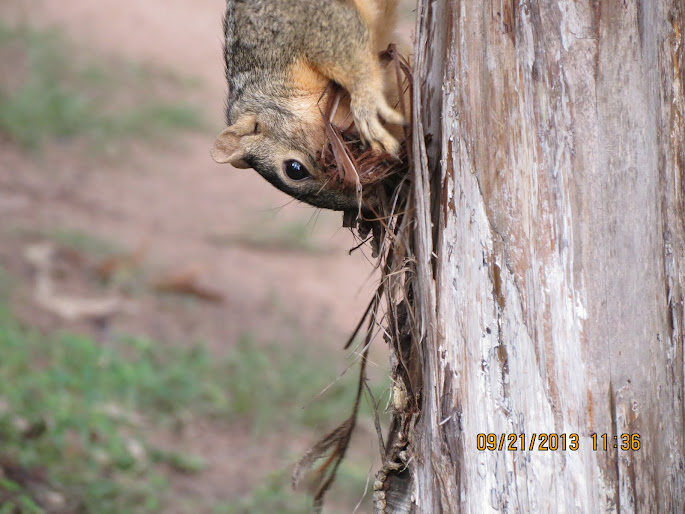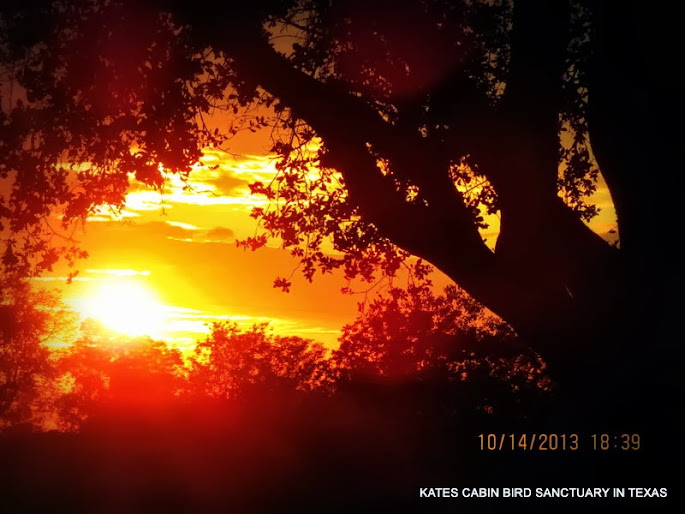
Hi Everybody!!
Back in the Day (before calendars), people relied on events in Nature for signals of Season Change. The squirrels increase the pace they stash nuts to the nest as a sign to 'get ready for winter'. You will see one squirrel stripping cedar bark off post and rolling it up in a ball to carry up and fortify the nest against the winter wind. Likewise, they are stuffing the cheeks full of food and scurrying up the trees to stash away for a cold and hungry day! Although in Texas, they will continue to eat at the feeding stations all winter, they still prepare the pantry in the nest. I would like to remind You to put out little bits of fruit, nuts and corn for the squirrels and winter birds. They have come to expect help from Humans after years of us feeding them to supplement the diet. Your info tonight is from Wikipedia on squirrels and beauty berry bush. Also, below you will find the link to Your photostudy. Enjoy!








Squirrrel eats Beauty Berries!


The squirrel is stripping cedar bark, then rolling it into a ball.


**New Feature**
Your photostudy is now located in my G+ Photo Album Gallery at the link below. Just click on the link and snap, presto-off you go!
link: https://plus.google.com/photos/117645114459863049265/albums/5935450526569169537
Album Highlights:
From G+ AutoBackUp:

http://en.wikipedia.org/wiki/Squirrel
Squirrel
From Wikipedia, the free encyclopedia
| Squirrels Temporal range: Late Eocene—Recent | ||||||||||
|---|---|---|---|---|---|---|---|---|---|---|
 | ||||||||||
Various members of the family Sciuridae
| ||||||||||
| Scientific classification | ||||||||||
| Kingdom: | Animalia | |||||||||
| Phylum: | Chordata | |||||||||
| Class: | Mammalia | |||||||||
| Order: | Rodentia | |||||||||
| Suborder: | Sciuromorpha | |||||||||
| Family: | Sciuridae Fischer de Waldheim, 1817 | |||||||||
Etymology
The word "squirrel", first specified in 1327, comes from Anglo-Norman esquirel from theOld French escurel, the reflex of a Latin word sciurus. This Latin word was borrowed from the Ancient Greek word σκίουρος, skiouros, which means shadow-tailed, referring to the bushy appendage possessed by many of its members.[1][2]
The native Old English word, ācweorna, survived only into Middle English (as aquerne) before being replaced.[3] The Old English word is of Common Germanic origin, withcognates such as German Eichhorn, Norwegian ikorn/ekorn, Dutch eekhoorn,Swedish ekorre and Danish egern.
Characteristics
Squirrels are generally small animals, ranging in size from the African pygmy squirrel at 7–10 cm (2.8–3.9 in) in length and just 10 g (0.35 oz) in weight, to theAlpine marmot, which is 53–73 cm (21–29 in) long and weighs from 5 to 8 kg (11 to 18 lb). Squirrels typically have slender bodies with bushy tails and large eyes. In general, their fur is soft and silky, although much thicker in some species than others. The color of squirrels is highly variable between—and often even within—species.[4]
In general, the hind limbs are longer than the fore limbs, and they have four or five toes on each paw. Their paws include an often poorly developed thumb, and have soft pads on the undersides.[5] The eastern gray squirrel is one of very few mammalian species that can descend a tree head-first. It does this by turning its feet so the claws of its hind paws are backward-pointing and can grip the tree bark.[citation needed]
Squirrels live in almost every habitat from tropical rainforest to semiarid desert, avoiding only the high polar regions and the driest of deserts. They are predominantlyherbivorous, subsisting on seeds and nuts, but many will eat insects and even small vertebrates.[6]
As their large eyes indicate, in general squirrels have an excellent sense of vision, which is especially important for tree-dwelling species. They also have very versatile and sturdy claws for grasping and climbing.[7] Many also have a good sense of touch, withvibrissae on their heads and limbs.[5]
The teeth of sciurids follow the typical rodent pattern, with large gnawing incisors that grow throughout life, and grinding cheek teeth set back behind a wide gap, or diastema. The typical dental formula for sciurids is 1.0.1.31.0.1.3[citation needed]
The lifespan of the Gray squirrel is approximately six years. Most urban squirrels do not reach their first birthday. This is due not to predators but rather to automobiles. Compare this to its rural counterpart, which often perishes from lack of food.[8][dubious ]
Behavior
Squirrels breed once or twice a year and give birth to a varying number of young after three to six weeks, depending on species. The young are born naked, toothless, and blind. In most species of squirrel, only the female looks after the young, which are weaned at around six to ten weeks of age and become sexually mature at the end of their first year. In general, ground-dwelling species are social animals, often living in well-developed colonies, but the tree-dwelling species are more solitary.[5]
Ground and tree squirrels are typically diurnal or crepuscular,[9] while flying squirrels tend to be nocturnal—except for lactating flying squirrels and their offspring, which have a period of diurnality during the summer.[10]
Feeding
Squirrels cannot digest cellulose, so they must rely on foods rich in protein,carbohydrates, and fats. In temperate regions, early spring is the hardest time of year for squirrels, because buried nuts begin to sprout and are no longer available for the squirrel to eat, and new food sources have not become available yet. During these times, squirrels rely heavily on the buds of trees. Squirrels' diets consist primarily of a wide variety of plants, including nuts, seeds, conifer cones, fruits, fungi, and greenvegetation. However, some squirrels also consume meat, especially when faced with hunger.[6] Squirrels have been known to eat insects, eggs, small birds, young snakes, and smaller rodents. Indeed, some tropical species have shifted almost entirely to a diet of insects.[11]
Predatory behavior has been noted by various species of ground squirrels, in particular the thirteen-lined ground squirrel.[12] For example, Bailey, a scientist in the 1920s, observed a thirteen-lined ground squirrel preying upon a young chicken.[13] Wistrand reported seeing this same species eating a freshly killed snake.[14] Whitaker examined the stomachs of 139 thirteen-lined ground squirrels and found bird flesh in four of the specimens and the remains of a short-tailed shrew in one;[15] Bradley, examining white-tailed antelope squirrels' stomachs, found at least 10% of his 609 specimens' stomachs contained some type of vertebrate, mostly lizards and rodents.[16] Morgart observed a white-tailed antelope squirrel capturing and eating a silky pocket mouse.[17]
See also
- American red squirrel
- Eastern gray squirrel
- Fox squirrel
- Red squirrel
- Squirrel relationship with humans
- Tree squirrel
- Western gray squirrel
http://en.wikipedia.org/wiki/Callicarpa
Callicarpa (beautyberry) is a genus of shrubs and small trees in the familyLamiaceae;[1][2][3] between 40-150 species are accepted by different botanists. They arenative to east and southeast Asia (where the majority of the species occur), Australia, southeast North America and Central America.
| Callicarpa | |
|---|---|
 | |
| Callicarpa dichotoma 'Early Amethyst' (Purple Beautyberry) | |
| Scientific classification | |
| Kingdom: | Plantae |
| (unranked): | Angiosperms |
| (unranked): | Eudicots |
| (unranked): | Asterids |
| Order: | Lamiales |
| Family: | Lamiaceae |
| Genus: | Callicarpa |
Growth[edit]
The temperate species are deciduous, the tropical species evergreen. The leaves are simple, opposite, and 5–25 cm long. The flowers are in clusters, white to pinkish. The fruitis a berry, 2–5 mm diameter and pink to red-purple with a highly distinctive metallic lustre, are very conspicuous in clusters on the bare branches after the leaves fall. The berries last well into the winter or dry season and are an important survival food for birds and other animals, though they will not eat them until other sources are depleted. The berries are highly astringent but are made into wine and jelly. Callicarpa species are used as food plants by the larvae of some Lepidoptera species including Endoclita malabaricus andEndoclita undulifer.
Uses[edit]
Insect repellent[edit]
American beautyberry has been used as a folk remedy to prevent mosquito bites.[4][5]Four chemicals isolated from Callicarpa have been shown to act as insect repellents:borneol,[6] callicarpenal, intermedeol, and spathulenol.[7] The use of callicarpenal has been patented by the United States Department of Agriculture Agriculture Research Service as a mosquito repellent.[4]
External links[edit]
| Wikimedia Commons has media related to Callicarpa. |
- Dr. Duke's Databases: Callicarpa americana - List of Chemicals
- Callicarpa info
- Eat The Weeds - Beautyberry
http://en.wikipedia.org/wiki/File:Callicarpa-bodinieri-flowers.jpg
...this is brendasue signing off from Rainbow Creek. See You next time!




O+O





No comments:
Post a Comment
Hi Everybody! Please say hello and follow so I know you are here! Due to the inconsideration of people trying to put commercials on my blog comment area, I have restricted use of anonymous posts. Sorry that some hurt all.
My public email is katescabin@gmail.com No spammers or trolls